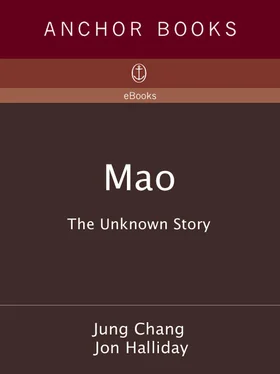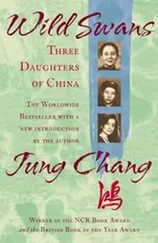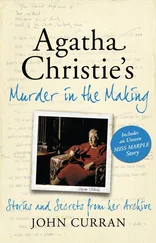Moscow brusquely ordered the CCP to enter serious negotiations with Chiang for an alliance. Mao had to accede, and talks about a “United Front” began in September between the CCP and Chiang’s representatives. Chiang had initiated the rapprochement. At the time the Long March ended, he had made overtures to Moscow, but the Russians told him he had to talk “directly with the Chinese [CP],” as a way of promoting the CCP.
Both Moscow and Mao kept the Young Marshal in the dark about this policy shift, and continued to mislead him on the issue that most concerned him — replacing Chiang. When the Young Marshal told Soviet ambassador Bogomolov in late July that he “hoped” that his “bloc with the [CCP], directed against Chiang Kai-shek and the Japanese, would be supported by the USSR,” the ambassador said absolutely nothing to suggest that Moscow was dead set against this notion. For his part, Mao encouraged the Young Marshal to go on thinking that Moscow might back him.
ALTHOUGH HE HAD decided to back Chiang as the head of China, Stalin was in no way cutting back on his clandestine efforts to build up the Chinese Red Army. In early September 1936 he endorsed a plan to ship a large cargo of arms to the CCP through Outer Mongolia. Mao’s wish list had included “monthly aid of 3 million dollars,” as well as “planes, heavy artillery, shells, infantry rifles, anti-aircraft machine-guns, pontoons,” together with Soviet personnel to fly the planes and operate the artillery. On 18 October he heard from the Comintern that “The goods are not as many as you requested in your cable of the 2nd [October] … and there are no planes or heavy artillery …” Still, the “foreign company” handling the shipment, a GRU dummy, would “supply 150 vehicles and provide drivers and gasoline; they can make two return trips … with about 550 tons to 600 tons” each trip. The number of rifles was almost exactly the same as the Russians sent to Spain, where the civil war had just broken out.
In October the Chinese Red Army began its operation to smash through to a delivery point in the desert near the Outer Mongolian border. At this stage, Mao had 20,000 troops in the base, and the other Red Army branches were about to converge there in response to his summons to join him. They included the troops led by his now disabled rival Chang Kuo-tao, who had spent the winter on the Tibetan border, at the mercy of Nationalist bombing. Thousands froze to death, and many others developed snow blindness. During the previous year, Kuo-tao had lost half the 80,000 troops he had commanded when he met up with Mao in June 1935.
Although he still had twice as many men, Kuo-tao now came as a junior partner. Sensing that he was done for, he became “very emotional,” as his colleagues witnessed. “He even shed tears. He said: ‘I’m finished. When we get to North Shaanxi, I’m going to prison …’ ” Though Kuo-tao was not exactly imprisoned, Mao was eventually to wreck his army further — and then purge him. But for now, Mao needed Kuo-tao’s large and efficient force to fight to the Outer Mongolia border.
The other branch of the Red Army that came to Mao now was headed by Ho Lung, a tough former outlaw. He had been herded to North Shaanxi by Chiang Kai-shek from his base on the Hunan — Hubei border. The three branches of the Red Army joined hands on 9 October 1936, making Mao the chief of an army of almost 80,000 men, twenty times the number he had fielded just a year before.
This was a formidable force, but in order to get to the Russian arms the Reds had to break through a powerful Nationalist army, and Chiang was determined to stop them. On 22 October he flew to Xian to take personal command, and this put the Young Marshal in a jam. The Young Marshal duly alerted the Reds about Chiang’s plans, as well as giving them cash and winter clothes, but that was his limit: he could not defy Chiang’s orders openly. So his men ended up fighting the Reds. Within a week, Mao’s push for the Russian supplies had been thwarted. A contingent 21,800 strong that had crossed the Yellow River was stranded on the other side. The main body of the Red Army pulled back to its corral in North Shaanxi, and was hemmed in again.
Mao asked Moscow for money urgently: “Be quick,” he cabled. The Comintern immediately sent US$550,000, but it could not solve the long-term problems. For food, there was just coarse black beans. Housing in this region was mainly yao-dong , quarters dug into hills, like grander caves, and many of the troops lacked even these. It had started to snow, and the soldiers had threadbare clothes and straw sandals. At the front, Peng De-huai, the chief commander, was living in a shepherd’s shelter, a hole in the ground one meter deep and two meters wide, on the edge of the desert, battered by furious sandstorms. Even Mao was enduring discomfort, as the Party Center had been forced into the small town of Baoan, where he and his heavily pregnant wife were living in a dank cave, with water dripping from the roof. Once, when a bodyguard tried to push the door open, he was stung by an outsize scorpion. Plague-bearing rats abounded, half the size of house cats, and so bold that they would sit on people’s chests while they slept and flick their tails across their faces, waking them up with a start.
BY THE END OF October 1936, the Reds were desperate. The Young Marshal saw an opportunity to rescue them, and gain favor with Moscow. His plan was simple, and extreme: to kidnap Chiang, who was about to step onto his turf. Even though the Young Marshal had not received the explicit commitment from Moscow that he had been seeking (his envoy had been given the runaround about his Russian visa), he calculated that saving the Chinese Red Army and having Chiang in his custody would change the whole equation for Stalin. This was a gamble, but the Young Marshal was a gambler. “My philosophy is gamble,” he had once said to his inner circle. “I might lose once or twice, but as long as the game goes on, the time will come when I get all my stakes back.” Having Chiang on his own turf was a once-in-a-lifetime opportunity.
The Young Marshal discussed his plan with Mao’s secret liaison, Yeh Jian-ying, telling Yeh he intended to stage a “coup d’état,” using this term (which in Chinese is transliterated as ku-die-da ). On 29 October, Yeh cabled Mao, using veiled language, that “there is a proposal to stay Chiang.” On 5 November, Yeh left for Mao’s place, carrying the coup plan.
The idea of kidnapping Chiang was the Young Marshal’s — but it was undoubtedly spurred on by Mao through his envoy, Yeh. The Soviet intelligence insider Aleksandr Titov records that “the question of arresting Chiang Kai-shek was discussed by … Yeh Jian-ying and Chang Hsueh-liang in November 1936.” And Mao very deliberately concealed the plan from Moscow, knowing that Stalin would be dead set against it. Mao was now acting directly contrary to Stalin’s interests. Chiang was more crucial to Stalin than ever. On 25 November Germany and Japan had signed a treaty known as the Anti-Comintern Pact, confronting the USSR with its worst nightmare — belligerent enemies on both flanks in an alliance, with Japanese-backed forces on the move westward along the southern flank of Mongolia, towards Soviet Central Asia. The very day the pact was announced, Stalin urgently ordered the Comintern chief Georgi Dimitrov to impress yet more strongly on the CCP that it had to abandon its anti-Chiang position and support a united government: “We need … a government of national defence” in China, Stalin told Dimitrov. “Work out a plan …”
Mao was running a considerable risk of infuriating Stalin by endangering Chiang. He tried to play safe by keeping his distance from the kidnap. Before taking the plunge, the Young Marshal cabled Yeh to return: “Vital thing to discuss. Please come instantly.” Mao held Yeh back, while pretending to the Young Marshal that Yeh was on his way. Then he spurred the Young Marshal on by wiring him that there was no prospect of the Communists reaching any compromise with Chiang, and saying the Reds were determined to continue their war against the Generalissimo. Mao gave the Young Marshal the impression that he, the Young Marshal, was their only possible partner, implying that Moscow would accept this.
Читать дальше










